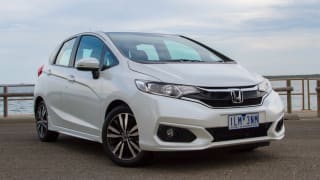
Honda Jazz 2018 review
Honda gave its Jazz range a little tweak in late 2017 to hand us the MY18 Honda Jazz. Some features were lost, and a few gained in an effort to keep up with the very fine Mazda2.
Browse over 9,000 car reviews
The new Volkswagen Polo has been so supersized you half expect to find Morgan Spurlock hiding in its (now much bigger) boot.
For one, this sixth-generation car is longer than the model it replaces. And it’s wider. And there’s more room for passengers and cargo than ever before.
Yep, the not-so-mini-Golf is bigger across the board. Except, that is, for under the bonnet, where a new and pint-sized 1.0-litre petrol engine is the order of the day.
But are they enough to push the bigger-than-ever Polo around?
| VOLKSWAGEN Polo 2018: 66 TSI Trendline | |
|---|---|
| Safety rating | |
| Engine Type | 1.2L |
| Fuel Type | Premium Unleaded Petrol |
| Fuel Efficiency | 4.8L/100km |
| Seating | 5 seats |
| Price from | $12,980 |
The new Polo arrives in a fairly limited range, with just the entry-level 70TSI Trendline and top-sec 85TSI Comfortline on offer initially - though they’re joined by a limited-run 'Launch Edition' which adds some extra styling kit.
Crystal-ball gazers will see a GTI sport edition following a little later this year, along with what will surely be the first of many special editions, the Polo Beats edition, with the associated RRPs for those models climbing accordingly.
For now, the price list kicks off with the Trendline, which will cost you $17,990 (five-speed manual), or $20,490 should you opt for a seven-speed 'DSG' dual-clutch auto. Those are drive-away prices, too, which makes them seem very sharp indeed. In short, it’s a new car at near second-hand price.
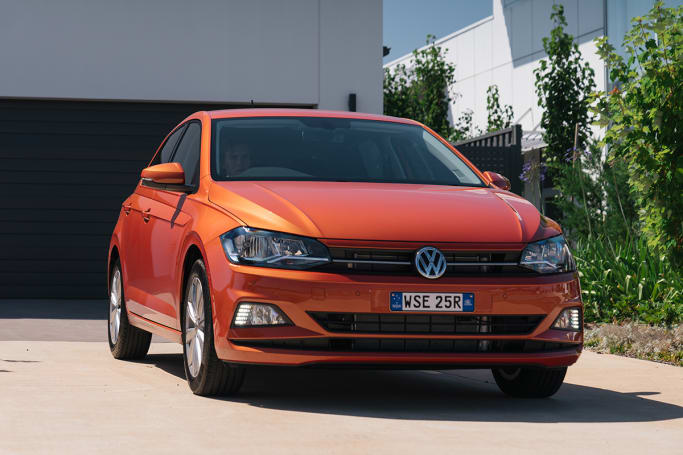
That money buys you cloth seats, a lovely (and vaguely flat-bottomed) leather steering wheel, keyless entry, central locking (with automatic unlocking and door locks that activate once you’re in motion), air conditioning, cruise control and electric mirrors. You also get halogen - not projector, bi-xenon or LED headlights - lights with daytime running lights.
There are some reminders of how much you’ve paid on the Trendline, though, like the 15-inch steel wheels with hubcaps - still, they’re better than 14 inch. Silver linings and all that.
Stepping up to the Comfortline trim level will set you back $19,490 for the six-speed manual ($20,490 drive-away), and $21,990 for the DSG automatic ($22,990 drive-away). You get more power, of course, but you’ll also upgrade to 15-inch alloy wheels (vs the hubcaps on the Trendline), rain-sensing wipers, some chrome highlights and a better quality cloth seat in the cabin. There are no leather seats, a panoramic sunroof or climate control on any of the trim levels.
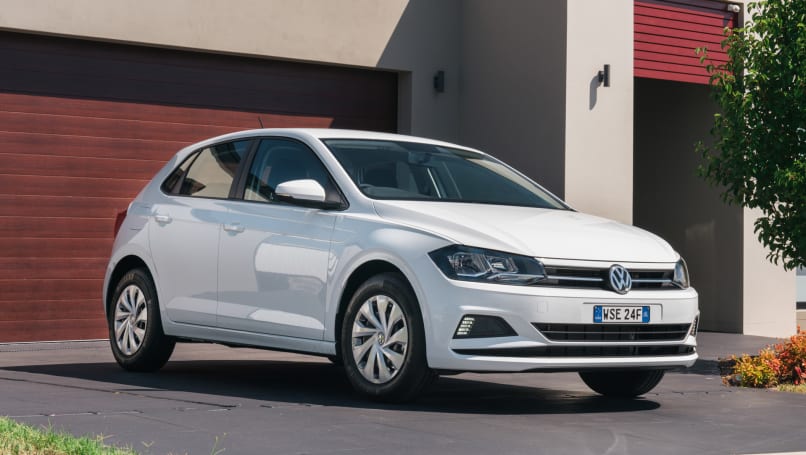
Tech gadgets across the Polo range include a fantastic 8.0-inch touchscreen that’s Apple CarPlay and Android Auto-equipped, and which pairs with a sound system with six speakers - but no sub-woofer, of course.
The screen controls your radio (though there’s no DAB) and there’s a CD player (but not a CD changer or a DVD player). Or the Bluetooth connectivity function will stream your MP3s. It’s an undeniably strong tech pack for a city car, and those features are unlikely to hurt resale value.
There’s no sat nav, but happily, your phone’s GPS system subs in as a navigation system, displaying directions from Google or Apple Maps up on the touchscreen.
Finally, a Launch Edition car ($20,490 manual, $22,990 automatic) completes the models comparison. arriving with 16-inch rims, tinted windows, fog lights and LED taillights, as well as a wireless charging station for your compatible phone - sorry iPhone users, you’ll need a special case. And those prices translate to $21,490 and $23,990 drive-away.
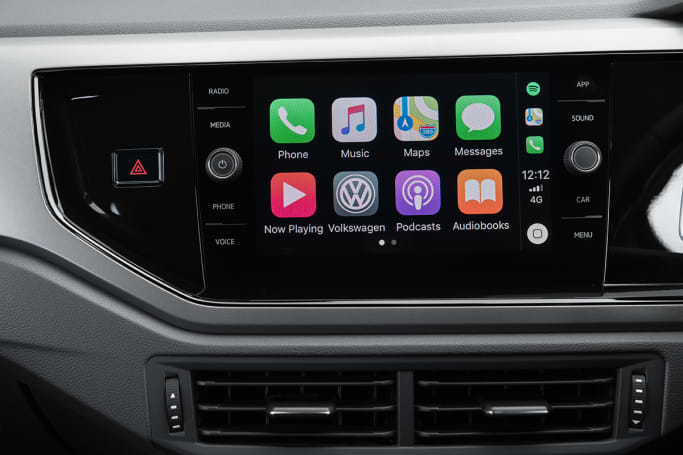
There has been no word on comfort or convenience packs as yet, but the night is still young for the sixth-generation Polo.
You can have your Polo in 'Pure White', which is free, or opt for 'Energetic Gold' (a kind of burnt orange), 'Limestone Grey', 'Reflex Silve'r, or a 'Deep Black Pearl', all of which will set you back $500. Not exactly a rainbow of colours, then, and there’s no blue, red, yellow or green, etc.
Roof rails or a roof rack to carry sports equipment, and premium floor mats appear in a fat official accessories guide.
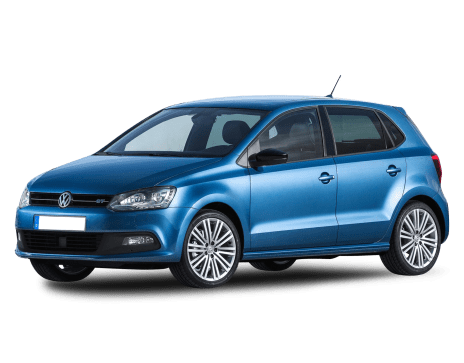
Well, a lot like a Golf that has been shrunk in the wash. But in a world of super-busy design, the Polo’s exterior treatment is refreshingly simple and unfussy.
A single accent line that runs the length of the body, joined by a kink at the base of the door, gives the Polo a clean, polished look, and it’s difficult to catch it at a bad angle.
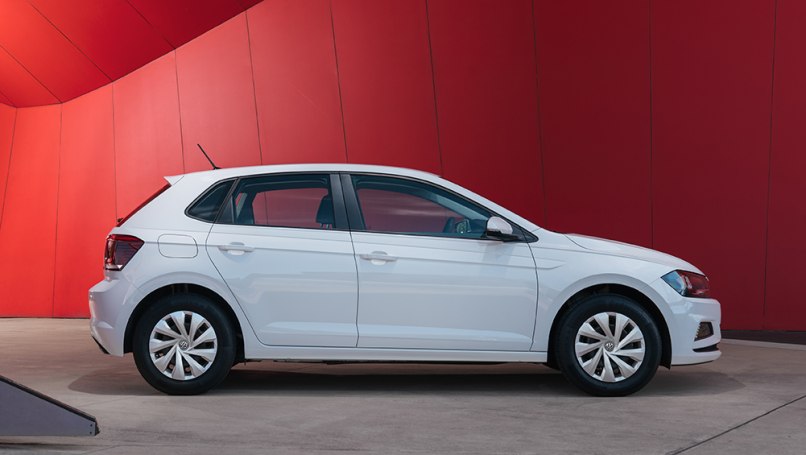
There’s no angry body kit, rear spoiler, side skirts, rear diffuser or front spoiler either, but in this case, that’s a good thing. You could perhaps level the accusation that it looks a little boring, but for mine, that just means it’s unlikely to age poorly.
The pick of the regular fleet, design-wise, has to be the Comfortline model - the hubcaps of the Trendline do it absolutely no favours.
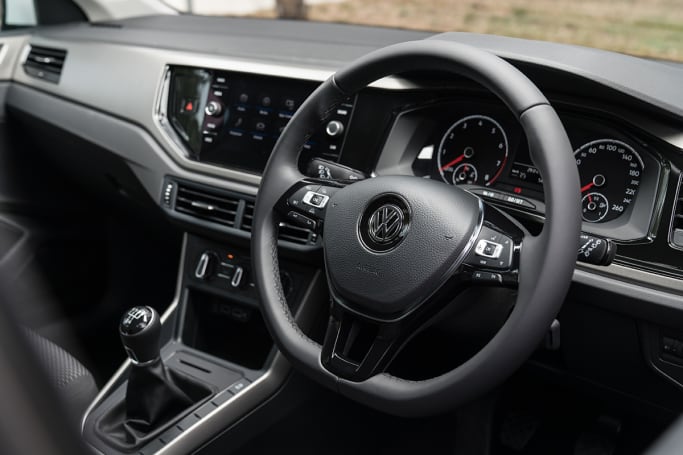
Inside, the interior treatment is clean and straightforward, with a two-tone dash with a soft top that’s joined by the very premium-looking 8.0-inch touchscreen in a gloss-black surround. Honestly, look at the interior images and tell us it looks like it belongs in an entry-level model.
The flat-bottomed wheel and silver-edging on the centre console are nice touches, too - as is the functionality of the driver’s binnacle that houses the trip computer (MFD) - but some of the plastics are utterly unforgiving to the touch.
Thanks largely to the merits of VWs MQB modular platform (the same chassis that underpins everything from the Golf to the Tiguan), the new Polo now stretches 4053mm in length (78mm longer than its predecessor) and sits on a wheelbase that is 81mm longer.
But of all the dimensions, it’s the 69mm in extra width (now 1751mm) that really counts here. It doesn’t sound like much, sure, but every centimetre counts in a city car, and it means you can fit full-size adults into the backseat without breaking any ribs.
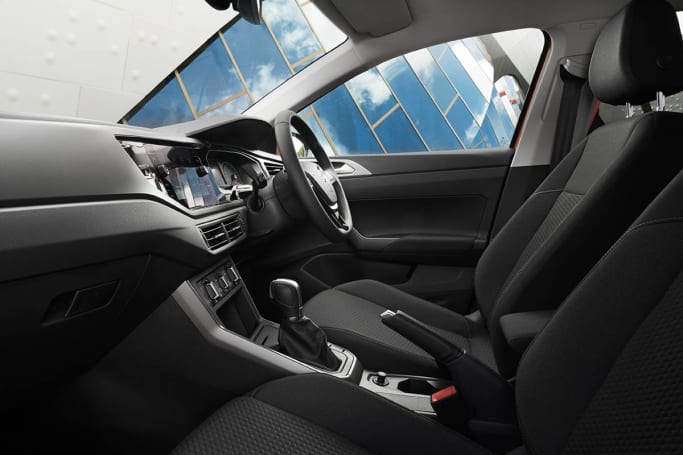
I still wouldn’t rush to go three adults across the back, but the improved interior dimensions ensure two can ride in plenty of comfort, with good head and rear legroom on offer for all but the tallest of passengers.
There’s little else to enjoy back there, though, with no air vents, USB connections or power sources. Hell, there aren’t even any cup holders. You do get two ISOFIX attachment points for your baby car seat, though, one in each window seat in the back.
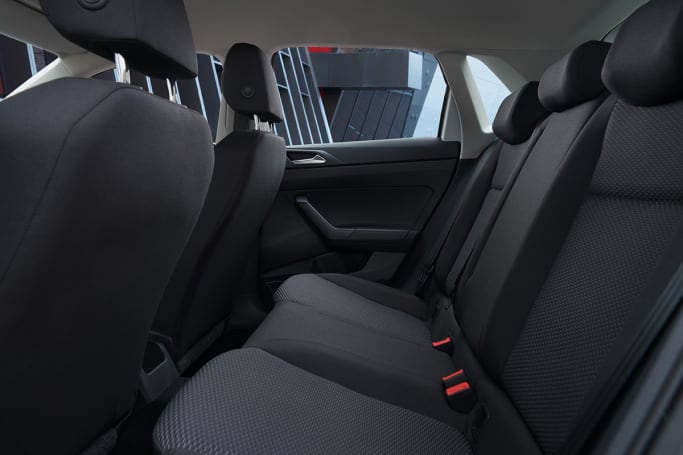
Up front, it’s only the cheaper plastics at key touchpoints (the area your knees and elbows constantly contact, for example) that diminish an otherwise comfort-packed space. The touch screen set-up is clean, clear and simple to use, and there are two USB connection points and a power source for all your gadget needs. There are two cup holders for up-front riders, room in each of the doors for bottles, and a central cubby that adds a little extra storage space.

Another benefit of the Polo’s growth spurt is the new boot space dimensions, now 71 litres bigger than before. It means you’ll now find 351 litres on offer - 1125 litres with the rear seats folded flat - a number VW proudly points out outshines even the bigger Mazda3’s luggage capacity.
Just the one engine on offer here; a tiny and turbocharged 1.0-litre, three-cylinder unit - a motor borrowed from the brand’s Up! - which is available in two states of tune. Both are petrol-powered, and there are no diesel, LPG, EV or plug-in hybrid options.
It’s a tiny engine size, but neither option feels underpowered. The cheaper 70TSI Trendline cars make use of the lower-spec version, good for 70kW at 5000rpm and 175Nm at 2000rpm. That’s enough to produce a fairly leisurely 0-to-100km/h sprint of 10.8 seconds.
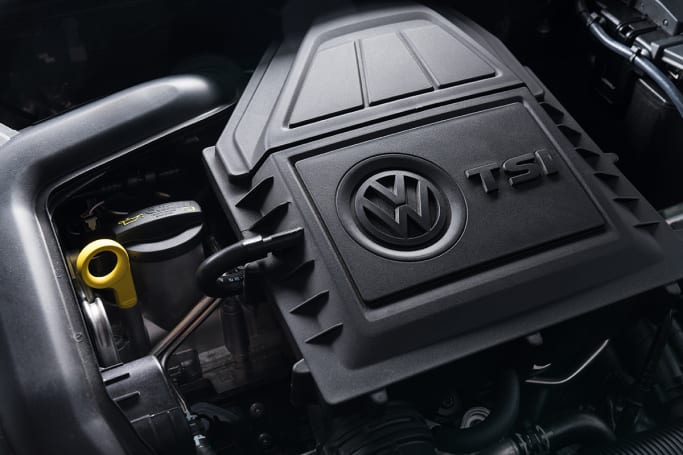
The 85TSI Comfortline shares the same capacity, but ups the horsepower to 85kW at 5000rpm and 200Nm at 2000rpm. That set-up will up the speed, too, with the acceleration to 100km/h now at 9.5 seconds.
They might not be the most pulse-quickening performance figures, but they do suit the personality of the little Polo, as does the turning radius of 10.6m.
A tow bar is absent from the Polo accessories list.
You can then choose between a five-speed manual (Trendline) or six-speed manual (Comfortline) gearbox, or you can spring for a seven-speed DSG gearbox in both. Either way, the transmission will shuffle power to the front wheels, with both the Trendline and Comfortline Polos exclusively front-wheel drive; there are no 4x4, all-wheel drive, or rear-wheel drive cars here.
You can all-but forget going off road, too - the ground clearance simply won’t allow it. Same with towing capacity, with a tow bar absent from the Polo accessories list.
The Trendline will sip 4.8 litres per hundred kilometres in manual guise (5.0 with the DSG) on the claimed/combined cycle, with emissions pegged at between 110-113g/km of C02.
The Comfortline ups the consumption to a claimed 5.1L/100km for the manual cars (5.0 with the DSG), with emissions of between 115-116g/km of CO2.
Either way, that’s near-diesel fuel economy/consumption, and they’re impressive mileage figures. The Polo’s fuel tank capacity size is 40 litres, and will accept 95RON fuel.
If the Polo doesn’t look like a cut-price city car, then the good news is that it doesn’t drive like one either. Our several-hour test route took us from city streets to broken B-roads, freeways to fast-flowing county runs, and the pint-sized Polo handled it all with little bother.
The single-tune suspension is definitely set up to favour firmer sportiness over comfort, and while you can catch the outside edges of the ride on seriously rough tarmac, it’s never overly teeth-rattling, and the little Polo will happily chug along no matter where you point it.
The steering, too, is perfectly suited to the character of the car, feeling connected without being darty, and plenty light enough for easy city use. The cabin is commendably quiet, locking out intrusive noise on all but the loudest road surfaces, too.
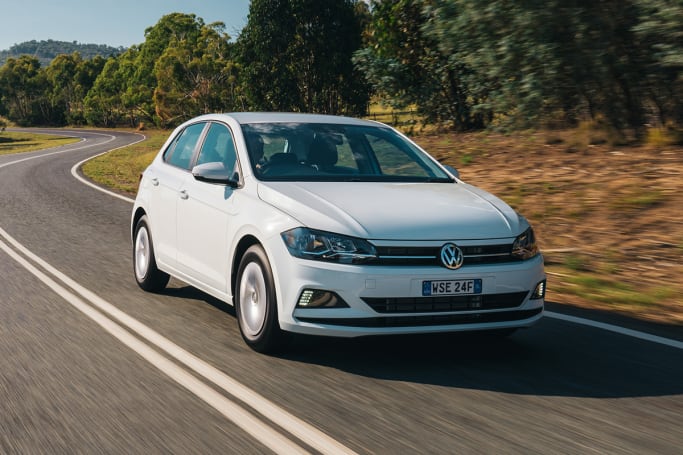
The biggest question, of course, is whether the little three-cylinder engine options pack enough grunt to push the Polo along faster than a slow-moving snail. But even the smallest output version never feels underpowered, and is more than peppy enough even with two adult passengers on-board.
The clever turbocharging has even largely done away with the lag sometimes associated with VW’s bigger cars, with the power arriving nice and early when you plant your foot from a rolling start, the 1.1-tonne (tare weight) Polo pulling away pretty cleanly.
What’s that? You want me to nitpick? Well, it can feel a little uncertain at times - especially when pulling away from hills - rolling back more than you’d like before engaging and pulling away. It’s far from a deal-breaker, but you’d need to get used to it.
Basic Warranty
3 years / unlimited km warranty
ANCAP Safety Rating

It’s a strong safety story, even from the base model, with every Polo arriving with an airbag count of six, a reverse camera, parking sensors and AEB with pedestrian detection. You get a fatigue-warning system and a tyre-pressure monitor, too, along with hill start assist, and the usual suite or braking and traction features like ESP.
An optional 'Driver Assistance Package' ($1400) adds VW’s manoeuvre braking system to the Polo, which combines with the rear parking sensors to act as AEB in reverse when you’re parking, along with adaptive cruise, blind-spot monitoring, rear-traffic alert and 'Park Assist', but no lane assist.
The Polo was awarded the maximum five-star safety rating when tested by Euro NCAP last year - a score that has since been adopted by Australia’s ANCAP.
The Polo is covered by a three-year/unlimited km warranty, and will require servicing every 12 months or 15,000km - the annual schedule helping to lower maintenance costs. Dealerships will likely offer an extended warranty, but always read the fine print.
There’s no need to crack the tool kit out either, with VW’s capped-price servicing - the 'Assured Price Program' - limiting the service cost for five years, and there’s roadside assistance for the duration of the warranty period, too. There’s a full-size steel spare tyre, and the owner’s manual will tell you all you need to know about the required oil type and capacity.
As with all cars reviewed here, if any owner issues, reliability issues or common faults are ever reported, including automatic gearbox problems, oil pump, clutch, injector, engine, battery or suspension issues, turbo complaints, defects, or issues with the timing belt or chain, you’ll find them on our owner’s page.
Where is the Volkswagen Polo built? Well, many places around the world. But ours will arrive from South Africa.
By far the biggest and most lasting impression from my initial time with the Polo is that it feels like a whole lot of car for the money, even in its base-model guise. There is a feeling of quality in (most of) the cabin and in the drive experience, and its improved ability to people or cargo will surely put it on more customer’s radars than ever before.
For ours, the entry-level Trendline with the DSG gearbox makes the most sense, getting the best of the standard features without breaking the bank.
| Vehicle | Specs | Price* | |
|---|---|---|---|
| 66 TSI Trendline | 1.2L, PULP, 5 SP MAN | $12,980 – 17,270 | 2018 Volkswagen Polo 2018 66 TSI Trendline Pricing and Specs |
| Urban (66Tsi) | 1.2L, PULP, 5 SP MAN | $9,680 – 13,310 | 2018 Volkswagen Polo 2018 Urban (66Tsi) Pricing and Specs |
| Urban + (81Tsi) | 1.2L, PULP, 6 SP MAN | $11,770 – 15,730 | 2018 Volkswagen Polo 2018 Urban + (81Tsi) Pricing and Specs |
| GTI | 1.8L, PULP, 7 SP AUTO | $20,240 – 25,630 | 2018 Volkswagen Polo 2018 GTI Pricing and Specs |
| Price and features | 8 |
|---|---|
| Design | 8 |
| Practicality | 9 |
| Under the bonnet | 8 |
| Efficiency | 8 |
| Driving | 8 |
| Safety | 9 |
| Ownership | 7 |
$10,980
Lowest price, based on 63 car listings in the last 6 months